Great Design Plant: Halesia Tetraptera
I first experienced Carolina silverbell (Halesia tetraptera) one summer at Mount Auburn Cemetery in Cambridge, Massachusetts. At that time it looked like a rather average tree, but it started getting interesting in the fall when the winged seedpods became more obvious. I really fell for this tree in the early spring, when it was covered inside and out with dangling white bells. Looking up from below, I only saw white flowers with delicate yellow centers.
Carolina silverbell is a North American native, with its indigenous population centered in the Carolinas and southwest to Alabama, but it can be grown successfully as far north as Boston. If you would like to add this beautiful native tree to your landscape, now is a good time to start scouting around for one (or more) that will work for you. Carolina silverbell is not a common tree at nurseries, but I have seen it listed at a number of larger nurseries. It would be best to call around. Smaller specimens are available online or by mail order.

Botanical name: Halesia tetraptera (formerly Haleasia carolina)
Common names: Carolina silverbell, silverbell tree, snowdrop tree
Origin: Native from southern West Virginia to Mississippi and northern Florida
Where it will grow: Hardy to -30 degrees Fahrenheit (USDA zones 4 to 8; find your zone)
Typical plant communities: Prefers rich hardwood slopes and stream banks in piedmont and mountain regions
Caution: The seeds of silverbell are toxic to humans and animals and should not be eaten.
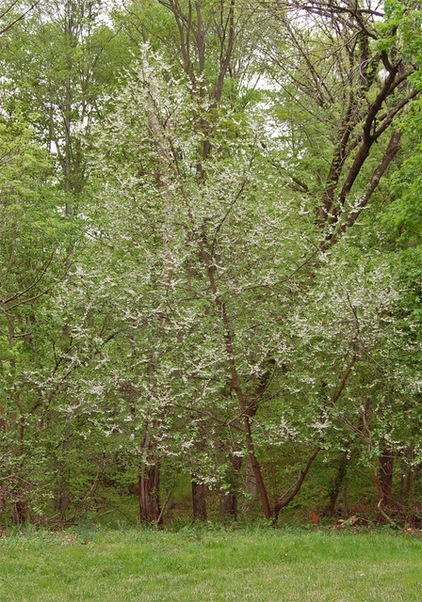
Water requirement: Does well in average to moist, well-drained soils; does not tolerate flooding
Light requirement: As an understory tree, it is shade tolerant but can be grown in full sun; it blooms well in shady and sunny locations.
Mature size: This is a highly variable plant; it typically reaches 20 to 35 feet tall and wide as an upright tree in the understory; out in the open, it may reach 50 feet or taller; it can also be grown as a multistemmed shrub.
Benefits and tolerances: Grows well on shady hillsides; with deep, wide-spreading lateral roots, it’s good for holding a slope.
Shown: On a slope under larger oaks and maples, the tree shown here is finishing up blooming in the middle of May.
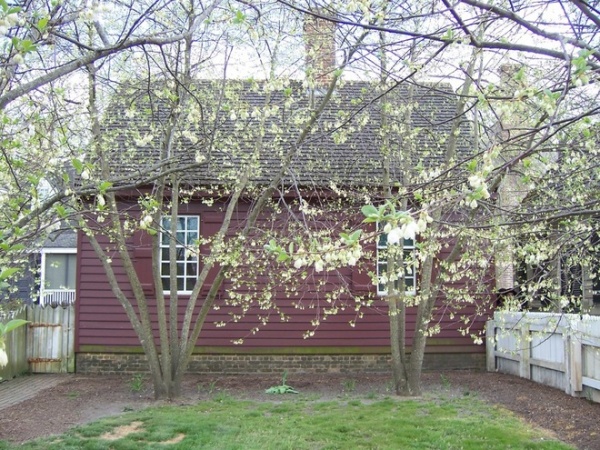
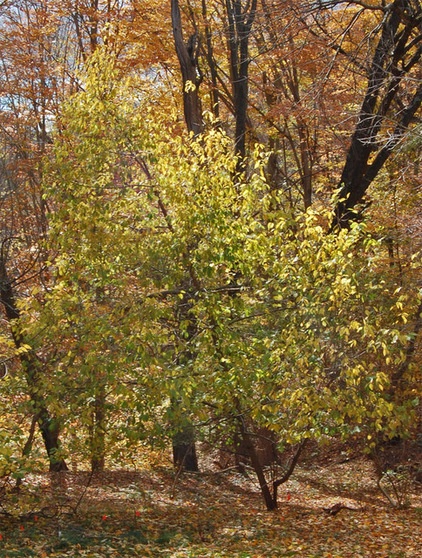
Seasonal interest: White flowers before the tree leafs out in early to midspring; simple, ovate green leaves in summer; unexceptional, rather subtle fall color (shown here), making it more of a supporting character than a star during this time of year
When to plant: Early spring is the best time to transplant balled and burlapped plants; container plants can be transplanted well then too.
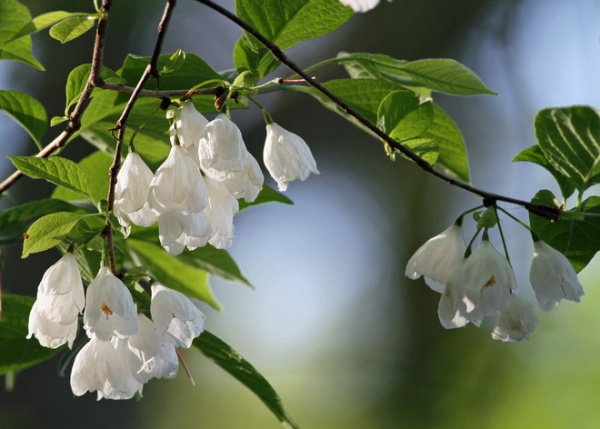
Distinguishing traits. The white flowers appear in early to midspring before the tree leafs out, about a week before dogwood trees bloom. The flowers consist of dangling, four-petaled bright white bells on ascending, outstretched branches. Some plants have flowers with a pale rosy cast. For this effect look for cultivars like ‘Rosea’ and ‘Arnold Pink’. The blooming period lasts about two weeks, and the flowers are still white when they fall to the ground, resulting in a white ring around the base of the plant.
The flowers are a particularly good food source for honey bees, and both bees and butterflies pollinate them. Caterpillars, such as of promethea moths, consume the leaves. Squirrels are known to feed on the seeds in the fall.
In summer simple, ovate green leaves fully cover the tree and give it a medium texture. The leaf density is high, meaning the ground beneath the canopy can be quite dark.
Initially I confused this tree with Japanese snowbell (Styrax japonicus), a member of the same botanical family. While each has bell-like flowers hanging from the branches in the spring, those of the snowbell have five petals, rather than four, and the shape of the tree is lower and broader compared with the upright form of silverbell.
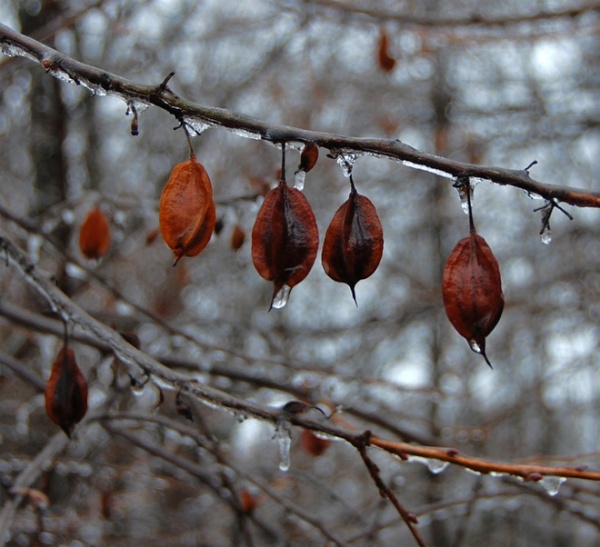
The flowers mature into unusual four-winged (hence, the “tetra” plus “ptera” of the botanical name) seedpods that last into winter. This photo shows the seedpods still on the tree after some freezing rain in December.
The autumn color is not exceptional. In early fall the leaves turn a clear yellow as the temperatures drop. Fall 2014 was unusual here in central Maryland, because we did not have a hard frost until mid-October and the leaves stayed on this tree longer than those of the nearby maples.
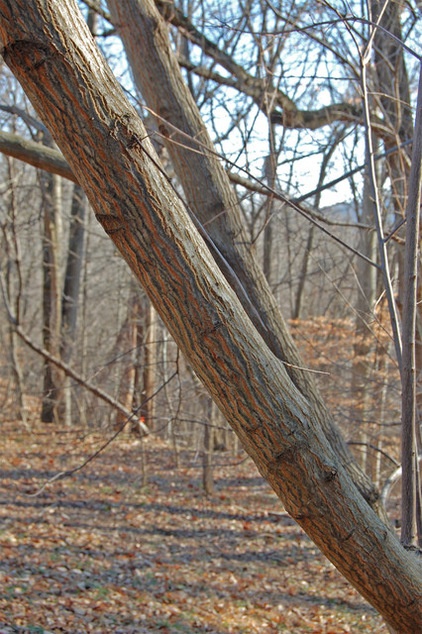
In its natural environment, silverbell grows as a small to medium-size understory tree, 20 to 35 feet tall. However, out in the open, with little competition, it gets much larger, growing to 50 or more feet in height.
The bark on intermediate aged branches has an interesting striped appearance when viewed from a few yards away.
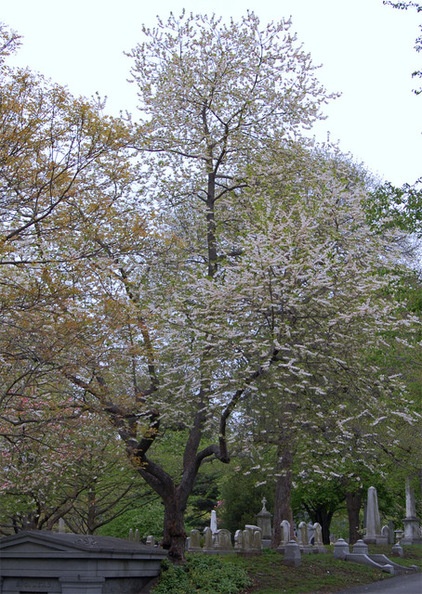
How to use it. Carolina silverbell works well as part of a woodland edge or in front of evergreens, where the white flowers will stand out against a darker background. It blooms well in shady locations, so it looks good interplanted with larger trees. As mentioned before, its deep roots can help hold a slope against erosion.
It can get large in open locations, so choosing a smaller-growing cultivar, like the shrub-forming ‘Meehanii’ (about 12 feet tall) or ‘Wedding Bells’, which reaches about 20 feet, would be prudent if you are planting next to a house.
Shown: Growing in the open, this tree at Mount Auburn Cemetery in Cambridge, Massachusetts, is well over 40 feet tall.
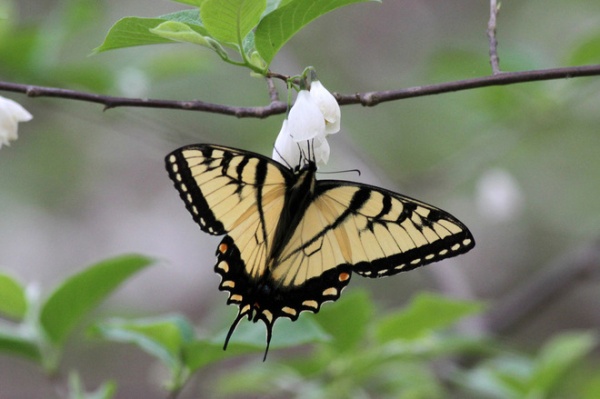
Planting notes. Spring is the best time to plant or transplant Carolina silverbell. It does best in well-drained acidic soils (pH 4.6 to 6) and will become chlorotic (the leaves will turn yellow) in alkaline soils. My silverbell is in soil that has a pH of 6.5 to 7.
In areas infected with the Asian longhorned beetle, Carolina silverbell is one of the species suggested as a nonsusceptible alternative for replanting.
To get a larger form of this tree, look for mountain silverbell (Halesia tetraptera var. monticola or H. monticola). Not only is it taller and wider, but the flowers are larger as well. Another species is two-winged silverbell (H. diptera), a close relative that is generally smaller, growing as a shrub or small tree. It blooms about two weeks later than Carolina silverbell.
More:
7 Spectacular and Practical Spring-Flowering Trees
Browse plants native to other regions of the U.S.












